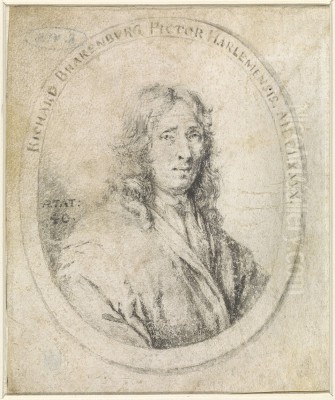
Richard Brakenburg stands as a notable figure among the painters of the Dutch Golden Age, a period renowned for its artistic flourishing and detailed depictions of everyday life. Active during the latter half of the 17th century and the dawn of the 18th, Brakenburg carved a niche for himself primarily as a genre painter, capturing the vibrant, and sometimes boisterous, spirit of Dutch society. His work, executed in the prevailing Baroque style, is characterized by a keen eye for detail, a dynamic handling of composition, and a sensitive use of light and color, offering valuable insights into the customs, celebrations, and social interactions of his time.
Origins and Artistic Formation
Born in Haarlem, Netherlands, in 1650, Richard Brakenburg entered the world during a peak era for Dutch art. While details about his earliest training can be sparse, historical sources point towards significant influences shaping his artistic path. It is widely accepted that he was associated with, and likely studied under, prominent Haarlem masters. Some accounts suggest a possible apprenticeship with Hendrik Mommers, a painter known for his Italianate landscapes and market scenes. However, the most profound and frequently cited influence on Brakenburg's style is undeniably that of the celebrated genre painter Jan Steen.
Jan Steen, himself a master of lively, often humorous, and morally nuanced depictions of Dutch life, operated studios in both Haarlem and Leiden. Brakenburg appears to have absorbed much from Steen's approach, particularly the penchant for crowded, animated scenes, expressive figures, and narrative richness. While Brakenburg clearly followed in Steen's thematic footsteps, he developed his own distinct artistic voice, often favouring slightly more orderly compositions than Steen's famously chaotic interiors, yet retaining a similar energy and observational acuity. He became a member of the Haarlem Guild of St. Luke, the city's painter's guild, signifying his status as a professional artist.
Style and Technical Prowess
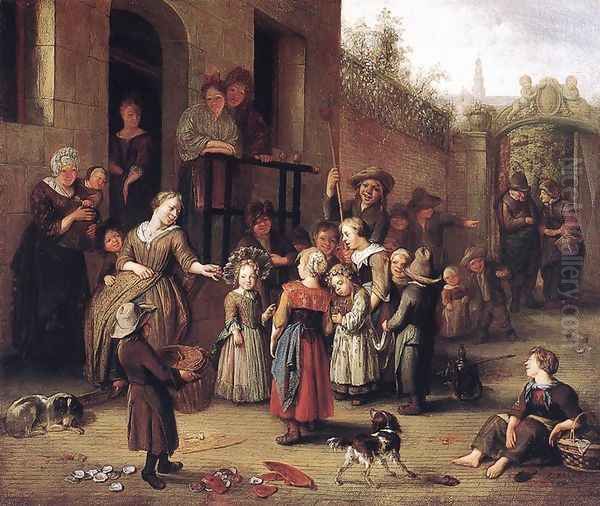
Brakenburg's artistic output is firmly rooted in the Baroque tradition, adapted to the specific tastes and themes popular in the Dutch Republic. His style is marked by several key characteristics. He possessed a fine painting technique, allowing him to render textures, fabrics, and small details with considerable precision. This attention to detail grounds his often bustling scenes in a tangible reality, inviting viewers to explore the minutiae of the depicted world.
His use of light and shadow (chiaroscuro) is another defining feature. While perhaps not as dramatic as that employed by Rembrandt van Rijn, Brakenburg skillfully used light to model figures, create depth, and highlight focal points within his compositions. Light often streams in from a window or an unseen source, illuminating key interactions or expressions, while other areas recede into softer shadows, adding atmosphere and directing the viewer's gaze. This careful manipulation of light contributes significantly to the vitality and mood of his paintings.
Furthermore, Brakenburg demonstrated a strong sense of color. His palette could range from earthy tones typical of tavern scenes to brighter, more varied hues employed in festive gatherings. He used color not just descriptively but also to enhance the overall composition and emotional tenor of the work. His compositions are often dynamic, filled with figures engaged in various activities, creating a sense of movement and lively interaction that prevents the scenes from feeling static.
Celebrations and Social Gatherings
A significant portion of Brakenburg's oeuvre is dedicated to depicting festivals and social gatherings, providing invaluable visual records of 17th-century Dutch customs. Among his most well-known works in this vein is the May Queen Festival (also known as May Queen's Celebration). This painting exemplifies his ability to manage complex, multi-figure compositions. Often depicted from a slightly elevated viewpoint, the scene bursts with energy, showing villagers celebrating the arrival of spring. Brakenburg captures the festive atmosphere through lively figures, colourful attire, and details like garlands and dancing, all rendered with his characteristic attention to detail and skillful use of light to unify the bustling scene.
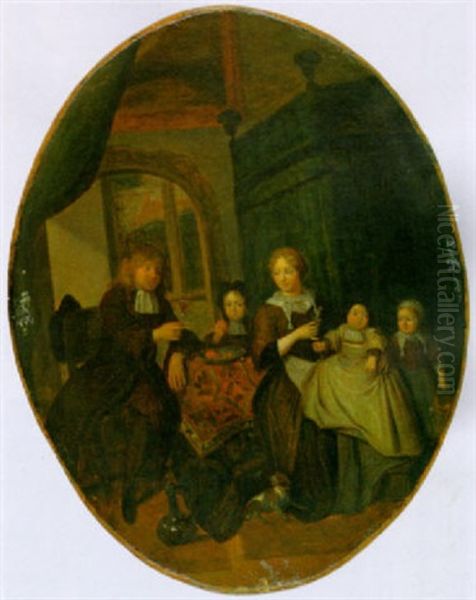
Another recurring theme is the celebration of Saint Nicholas' Day (Sinterklaas), a cherished Dutch tradition. Brakenburg painted this subject multiple times, with notable examples dated around 1685, 1698, and circa 1700. His Saint Nicholas Festival (1698) offers a glimpse into a middle-class Dutch household during the celebration. It typically shows children receiving gifts, the family gathered together, and the general sense of excitement and domestic warmth associated with the holiday. These works are significant not only for their artistic merit, showcasing Brakenburg's skill in depicting interiors and group dynamics, but also as historical documents illustrating the enduring importance of this festival in Dutch culture. His name even appears in historical records from 1685 and 1700 connected to the festival, further cementing his association with this theme.
Tavern Scenes and Everyday Life
Alongside festive occasions, Brakenburg frequently turned his attention to more commonplace scenes of daily life, particularly those set in taverns or domestic interiors. Works like A Country Inn (sometimes dated 1660, though this early date might warrant careful consideration given his birth year of 1650, perhaps indicating an early work or a later attribution) and Figures outside a Tavern capture the social life unfolding in and around these public houses. These paintings often depict peasants or townspeople drinking, playing games, conversing, or interacting in ways that reflect the social fabric of the time.
In these scenes, Brakenburg continued to demonstrate his debt to Jan Steen and contemporaries like Adriaen van Ostade, who also specialized in peasant genre scenes. However, Brakenburg's figures, while lively, sometimes possess a slightly more refined or less caricatured quality than those of Ostade. He observed human behaviour closely, capturing gestures and expressions that convey camaraderie, revelry, or sometimes minor conflicts. The settings themselves are often rendered with care, showing the details of the tavern interior or the architecture outside, contributing to the overall sense of place.
Other Subjects and Notable Works
While best known for his genre scenes, Brakenburg also tackled other subjects, including historical, mythological, and religious themes, although these appear less frequently in his surviving work. His versatility is further demonstrated in works like A Surgeon Preparing to Let Blood from the Foot of a Girl. This painting showcases his ability to handle a more intimate, focused scene, again demonstrating his skill in rendering detail, textures (like fabrics and medical instruments), and the subtle interplay of light, while capturing the tension and specific nature of the medical procedure depicted.
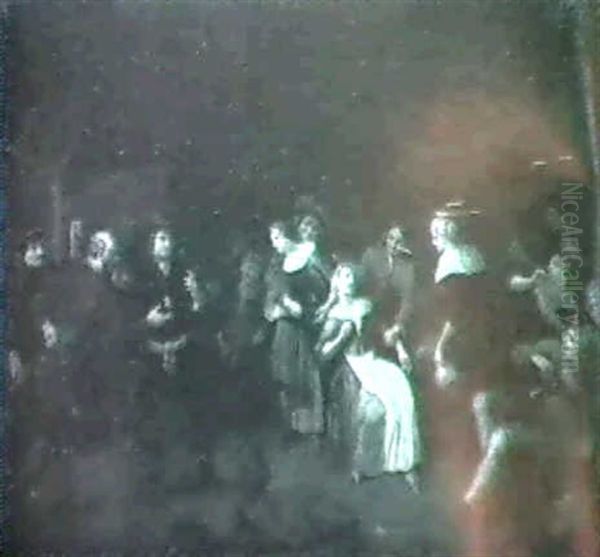
Another mentioned work, Family Portrait, highlights a different facet of his potential output. While specific details of this painting are less discussed in the provided context, its use as a subject for discussing symbolism in art education suggests it likely contained elements meant to convey status, relationships, or virtues, common features in Dutch portraiture of the era, mastered by artists like Frans Hals or Nicolaes Maes in their respective periods. The inclusion of specific objects or arrangements in such portraits often carried deeper meanings understood by contemporary viewers. Brakenburg's engagement with portraiture, even if less prolific, places him within the broader spectrum of artistic practice during the Golden Age.
Context within the Dutch Golden Age
To fully appreciate Richard Brakenburg's contribution, it's essential to view him within the rich tapestry of the Dutch Golden Age. He worked during a time when Dutch art reached unprecedented heights, characterized by specialization and a burgeoning art market catering to a prosperous merchant class. Brakenburg's focus on genre painting placed him alongside numerous talented contemporaries exploring similar themes.
His primary influence, Jan Steen, was a giant in the field. Other notable genre painters included Gerard ter Borch, known for his exquisitely refined scenes of upper-class life, and Pieter de Hooch, celebrated for his tranquil domestic interiors with masterful light effects. While Brakenburg's style differed, the shared interest in depicting Dutch life creates a fascinating dialogue between their works. The mention of similar carpets appearing in paintings by Brakenburg, Ter Borch, and De Hooch points to shared material culture and decorative tastes of the period, reflected accurately by these observant artists.
The artistic landscape also included masters of other genres who defined the era. Rembrandt van Rijn dominated portraiture and history painting with his profound psychological depth and dramatic use of light. Johannes Vermeer created serene, luminous interior scenes of unparalleled intimacy and technical brilliance. Landscape painting flourished with artists like Jacob van Ruisdael capturing the Dutch countryside. Still life reached exquisite levels of realism with painters such as Willem Kalf. Figure painters like Gabriel Metsu offered polished depictions of daily activities. Brakenburg operated within this incredibly vibrant and diverse artistic environment, contributing his own distinct perspective on Dutch society.
Legacy and Historical Reception
Richard Brakenburg enjoyed considerable recognition during his lifetime. His paintings were appreciated for their skillful execution, lively subjects, and detailed observation. The fact that his style was imitated by other artists, as noted in historical sources, attests to his influence within artistic circles, even if he is not recorded as having had formal pupils in the same way as some of his more famous contemporaries. His works captured a specific aspect of Dutch life that resonated with patrons and fellow artists alike.
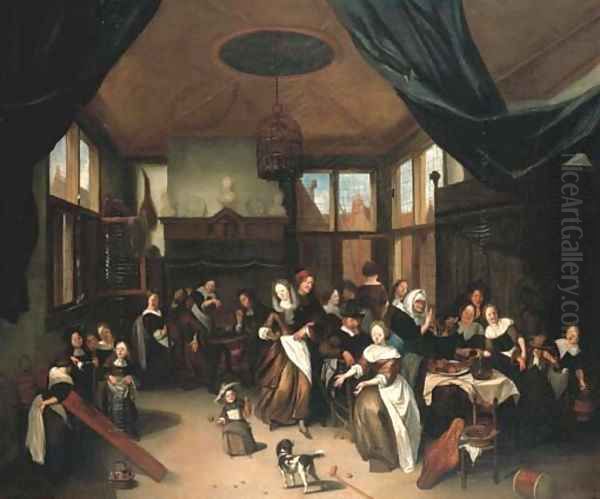
After his death in Haarlem in 1702, Brakenburg's reputation endured, though perhaps overshadowed by the towering figures of Rembrandt, Vermeer, and Hals. However, his paintings continued to be valued, appearing in collections and occasionally on the art market, as evidenced by auction records like the sale of Figures outside a Tavern in 2016. His work remains important for art historians studying the Dutch Golden Age, particularly those interested in genre painting, social history, and the influence of Jan Steen.
Furthermore, the use of his works, such as Family Portrait, in educational contexts highlights their enduring relevance. They serve as valuable tools for teaching art appreciation, helping students understand artistic elements like composition and color, analyze symbolism, and explore the ways art reflects cultural values and historical periods. His depictions of festivals like Saint Nicholas' Day also provide a direct visual link to enduring cultural traditions.
Conclusion: A Valued Golden Age Painter
Richard Brakenburg emerges from the historical record as a talented and productive painter of the Dutch Golden Age. Deeply influenced by Jan Steen yet developing his own recognizable style, he excelled in capturing the energy and detail of Dutch life, from boisterous festivals and tavern scenes to more intimate domestic moments. His skillful handling of light, color, and composition brought these scenes to life, creating works that were admired in his own time and continue to be appreciated today.
While perhaps not reaching the universal fame of some of his contemporaries, Brakenburg holds a secure place in the history of Dutch art. His paintings offer a vibrant window into 17th-century society, documenting its customs, celebrations, and everyday interactions with keen observation and artistic flair. As a chronicler of his time and a skilled practitioner of Baroque genre painting, Richard Brakenburg remains a significant figure whose work enriches our understanding of one of the most remarkable periods in art history.